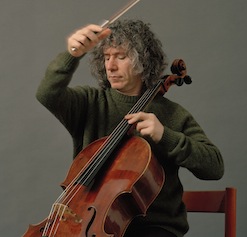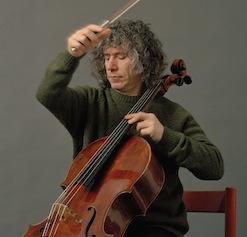
Under the auspices of San Francisco Performances, cellist Steven Isserlis and pianist Robert Levin performed an all-Beethoven concert at Herbst Theatre on Saturday, playing some sonatas and several themes and variations. They complete the Beethoven cello cycle Sunday with three more sonatas and one more theme and variations.
Beethoven’s first couple of cello sonatas (Opus 5) are more like piano sonatas with the cello playing along. In Isserlis’ comment inserted into the program, he admits that the piano gets the “lion’s share of the notes.” As Beethoven would have played the piano part himself, he “was not going to let himself be overshadowed by a mere cellist!” Isserlis seemed more than happy to let Levin shine with the dazzling arpeggiations on the pianoforte. Levin played with freely flowing grace and crisp clarity.
But Isserlis wasn’t going to just sit in the shadows. Even with Beethoven’s mind-numbingly easy lines in those early sonatas, Isserlis milked drama out of every gesture; he whisked the bow into the air in grand, circular gestures; he swung his huge mop of curly gray hair to and fro; he kicked his heels in the air; when landing on open strings and not using his left hand on the fingerboard, he clenched his fist in the air upward in Beethovenesque defiance. Some listeners get annoyed by this kind of demonstrative showbiz, but I like it — anything to make the concert more interesting and help convey the message of the music.
Isserlis ran this Beethoven marathon on the gut strings of his cello. At times they sounded wonderful — the sound was sweet and open, more organic than the modern standard of wound-steel strings. At other times, specifically on loud and fast pages, they failed to “speak” properly, and an itchy, scratching sound resulted.
Isserlis seemed more than happy to let Levin shine with the dazzling arpeggiations on the pianoforte.
The gut strings blended well with Levin’s fortepiano. He played on an instrument made in 1822 and recently restored. It has a brighter, more transparent sound than the modern piano, which allows the cello to be heard without having to be played too loudly. On the negative side, it has fewer expressive possibilities. Yet, with period instruments and two performers highly aware of period-performance practice (both have written scholarly articles and have been consulted for critical sheet music editions), Levin’s and Isserlis’ interpretations provide a very good stab at what Beethoven’s audiences would have heard in 19th-century Vienna.
Ludwig a Software Guy
I recently watched a TED talk about Beethoven as a businessman. The speaker, José Bowen, asserts that Beethoven can be compared to Bill Gates. He makes an analogy between two new technologies that were suddenly available to the masses: the fortepiano in Beethoven’s time and the personal computer in ours. He then extends the analogy to the piano as hardware and sheet music as software. Beethoven was one of the first musicians to become world-famous as a publishing composer, as opposed to solely a performer (Bach and Mozart were not so much known for their publications as for their live performances). In short, Beethoven was a software guy, not a hardware guy. Any performer worth his salt must have Beethoven in his repertoire, just as virtually every PC runs Windows. And just as Microsoft still monopolizes the software market, Beethoven still monopolizes concert programs — and it’s not only this concert; S.F. Performances’ calendar is full of Beethoven (it presented a Robert Greenberg lecture on Beethoven only a few weeks ago).
Levin’s and Isserlis’ interpretations provide a very good stab at what Beethoven’s audiences would have heard in 19th-century Vienna.
Beethoven didn’t merely write masterpieces. He also wrote Vienna’s pop music, setting variations on popular tunes. Those chosen for this recital were from Handel’s Judas Maccabeus and Mozart’s “Ein Mädchen oder Weibchen” from The Magic Flute. They were obviously written to please salongoers and amateur chamber musicians. The variations are in perfect Viennese style, Levin and Isserlis playing them with all the proper Viennese phrasing. But a recital’s entire first half made of this stuff can be tedious, or worse, like eating too many puff pastries. This isn’t what made Beethoven Beethoven; he only wrote these to pay the bills. Still, the stubborn insistence on playing the full cycle means we still had to sit through them.
After a much-needed intermission, a horn sonata transcribed for cello was performed — an interesting piece that works very well on the cello. Finally, in his Op. 69 Sonata in A Major, we got Beethoven in his full heroic glory, given a thrilling reading by Isserlis and Levin. The sinuous lines sounded extremely expressive on gut strings, especially coming after so many formulaic arpeggiations; a breath of Romantic air after a whole lot of Classicism, and a simulation of what 19th-century audiences experienced when first hearing Beethoven’s daring experiments.
For an encore, the duo played Beethoven juvenilia: a theme and variations for mandolin and cello, WoO 43. Coming after the epic Opus 69, it felt like a sigh of relief. It wouldn’t have sounded nearly as good after the first half.

